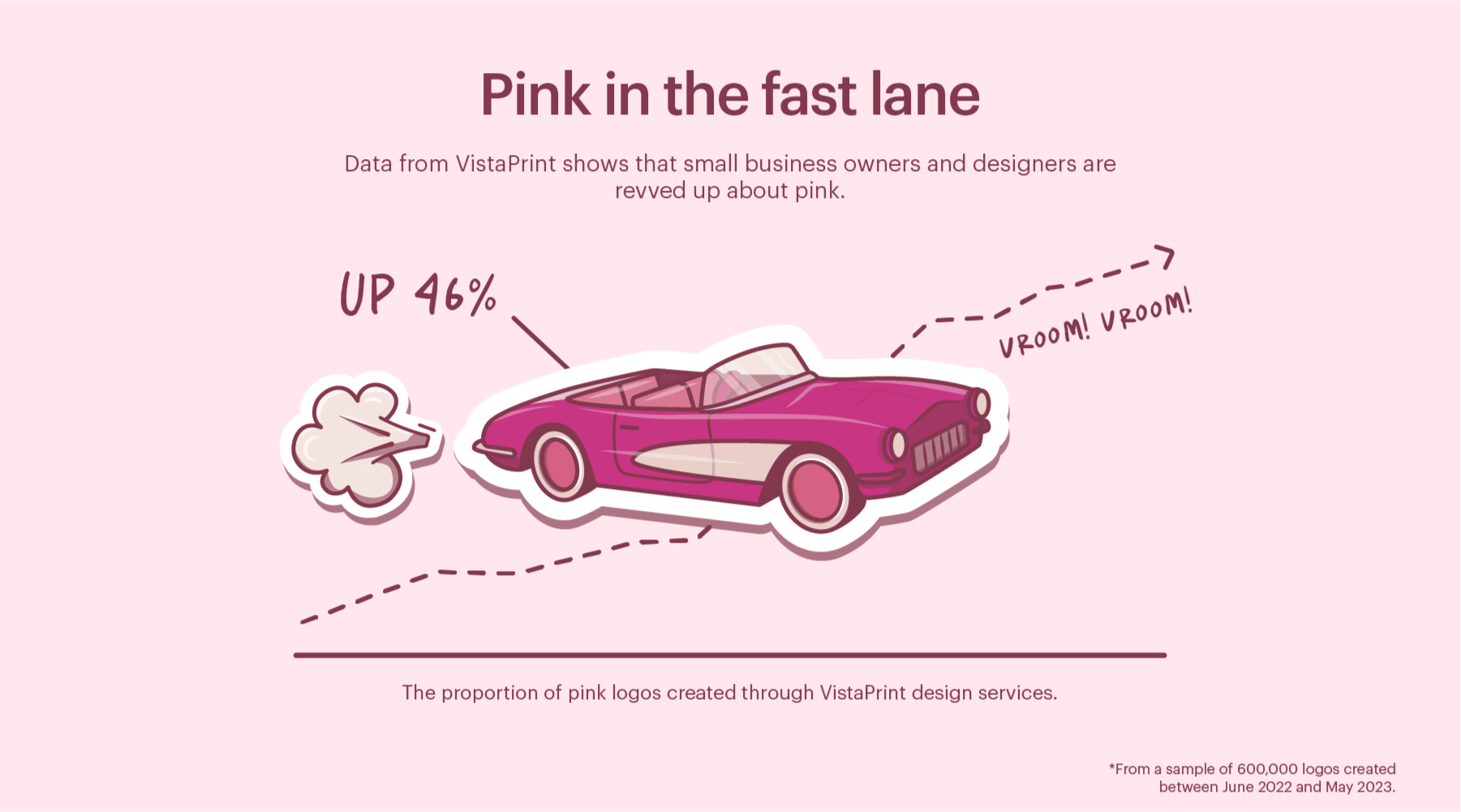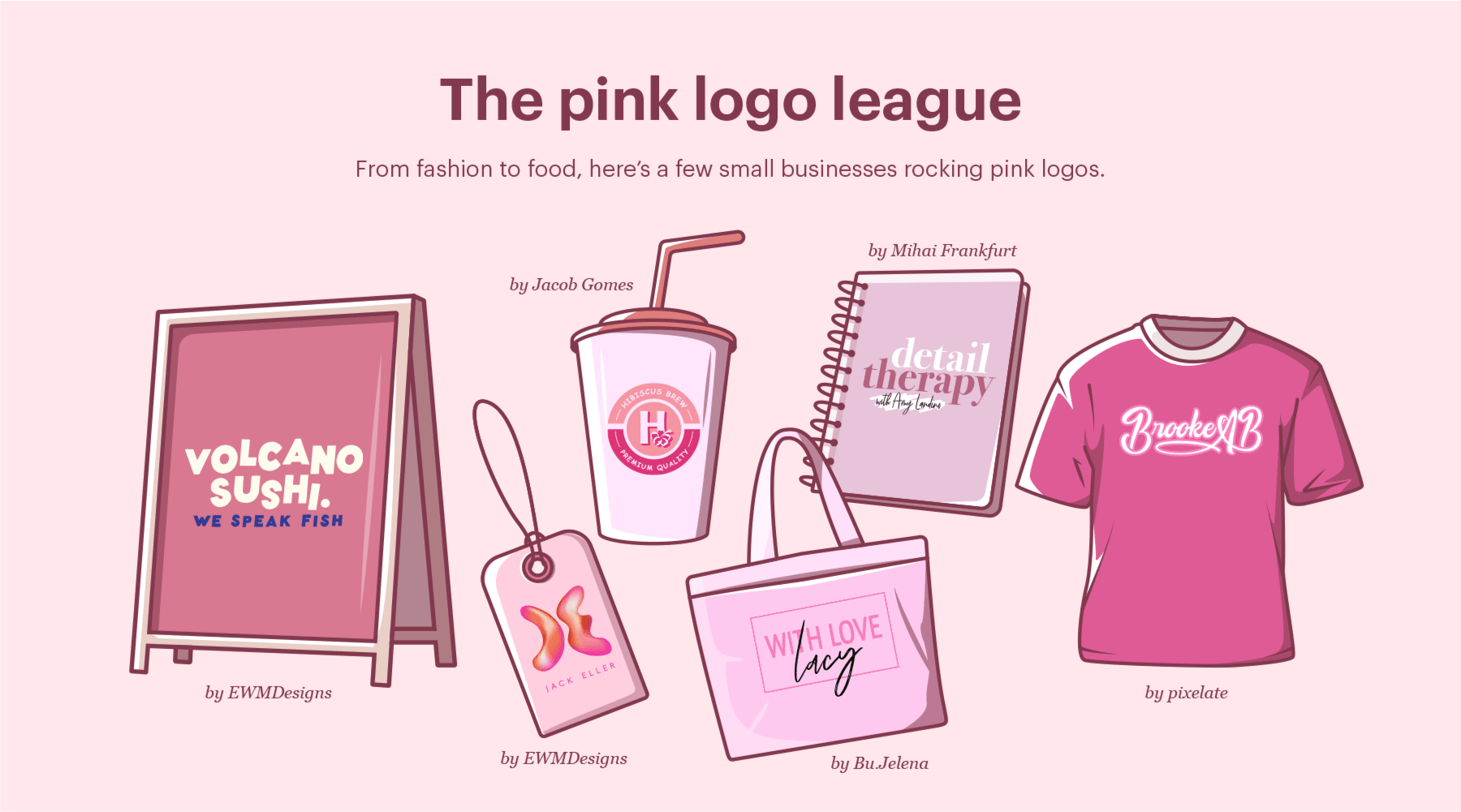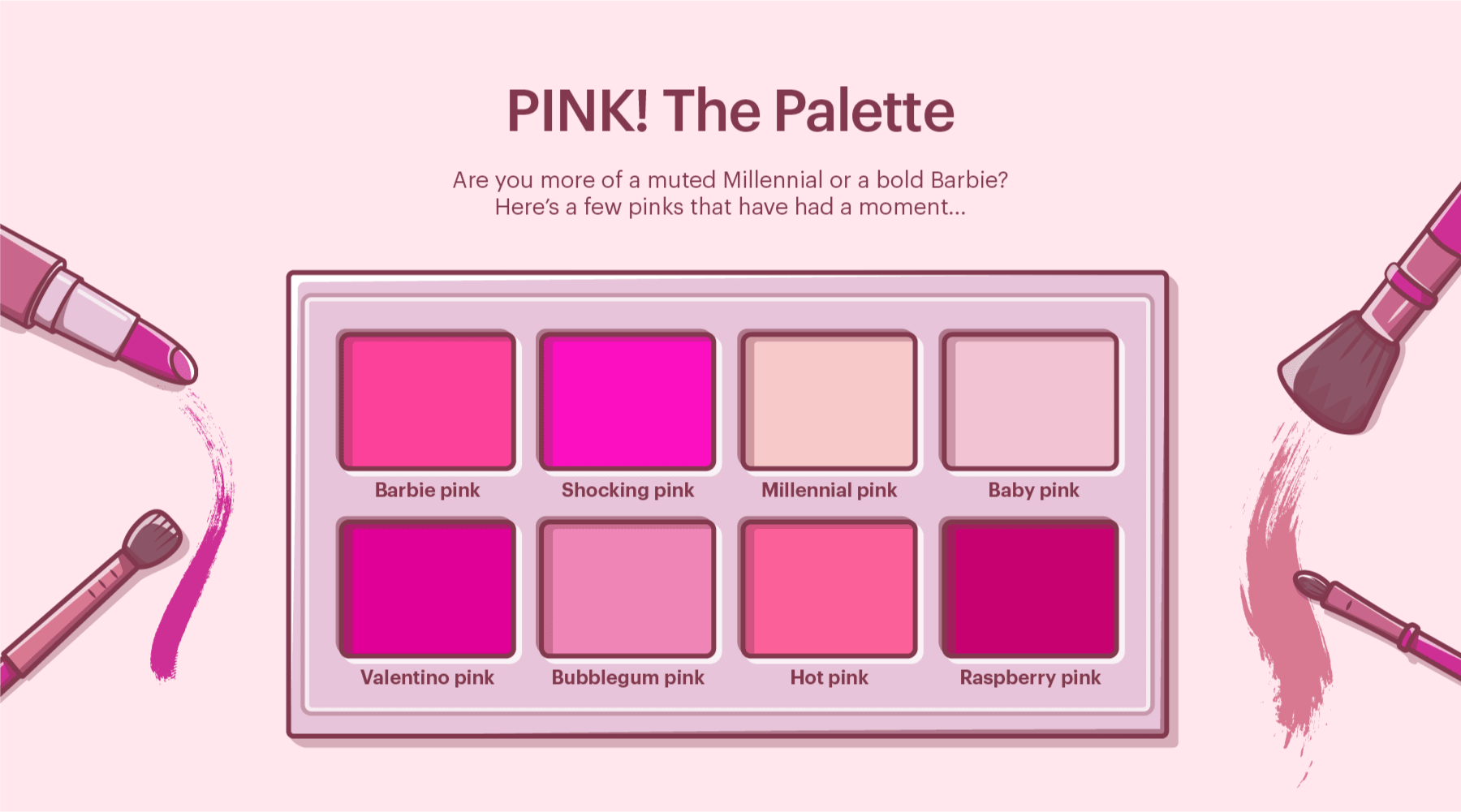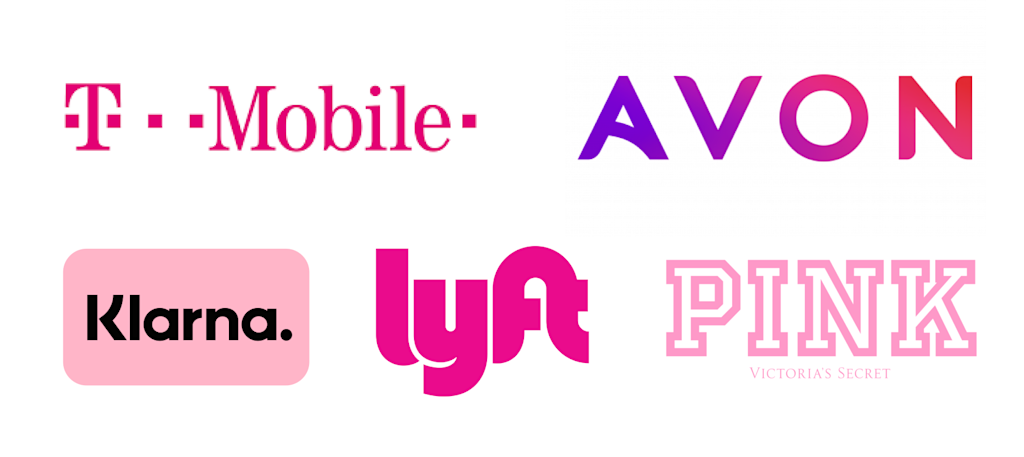Estimated reading time: 4 minutes
What comes to mind when you think of pink? Is it the colour of frilly dresses, fun cocktails and Valentine’s Day cards? Or is pink more powerful and subversive — the colour of women’s marches and queer reclamation? Maybe it reminds you of Barbie, the glamorous, occasionally divisive plastic doll whose forthcoming film adaptation has helped spark a hot pink renaissance and turned #Barbiecore into a viral trend.
However you feel about pink, it’s clear that it’s in the spotlight, and not in a muted Millennial way. Barbie pink is bold. It’s unapologetic. And it’s everywhere, from high fashion to home decor.
The Barbiecore trend is influencing small business owners, too. According to new data from VistaPrint, more brands are embracing pink in their design and marketing materials. That means pink is back, and it could make a big difference to your branding.
But first, what is Barbiecore?
Barbiecore is a playful fashion and design aesthetic inspired by the Mattel company’s iconic Barbie doll and characterised by her signature shade of hot pink.
Basically, Barbiecore is pink. Very pink.
Though hot pink is the linchpin, the broader Barbie trend is also a homage to everything that’s made the doll a beloved but complicated cultural touchstone: she’s bubbly, confident and, of course, plastic.
Barbiecore can also include bubblegum shades of blue and pink, as well as glitter, sparkles, latex or plastic textures, glossy details, exaggerated silhouettes and an unabashed love of excess (which aligns Barbiecore with another major trend — maximalism).
It also borrows elements from early noughties culture and Millennial Kitsch, epitomised by films like 2001’s Legally Blonde and 2004’s Mean Girls, where a high school clique named The Plastics famously declared: ‘On Wednesdays, we wear pink’.
How the Barbiecore trend put pink back in the spotlight
Barbie-esque style and design have existed in some form since the first Barbie doll debuted in 1959, but it returned to the zeitgeist in a big way in 2022 — thanks to the fashion world’s post-pandemic love of bright, mood-boosting hues, as well as public anticipation surrounding director Greta Gerwig’s live-action Barbie film.

In early 2022, Italian fashion house Valentino launched a Paris Fashion Week collection based around a custom shade of shocking pink that it developed with Pantone. But the trend reached new heights a few months later when leaked photos from the set of the Barbie movie went viral.
Paparazzi snaps of star Margot Robbie in a hot-pink flared trouser suit and eye-wateringly neon spandex launched a flurry of enthusiastic tweets. #Barbiecore became a trending hashtag on TikTok, and suddenly, Barbie pink was everywhere.
In 2022, Etsy reported that searches for hot-pink fashion items were up 35% compared to the previous year, while Pinterest saw a 75% increase in searches for ‘Barbie outfit’. According to Google data, global search traffic for ‘Barbiecore’ started to spike towards the end of June 2022. And it’s been trending ever since.
How Barbiecore is influencing logo and branding trends at VistaPrint
Here at VistaPrint, we wanted to know how the Barbiecore trend has affected small business owners, and whether it’s inspired their branding decisions. So, we looked at a sample of 600,000 logos created through VistaPrint design services, including 99designs by Vista and the free Logomaker by VistaPrint tool, to see whether more brands and designers were embracing pink.
We found that in the last 12 months, the proportion of pink logos increased by a whopping 46% — an indication that small business owners and designers are more open to using pink in branding.1
The industries where pink was used most were: food, retail, entertainment, cosmetics, health and technology.

But small business owners who want to include pink in their branding don’t have to worry they’re jumping on a bandwagon. Despite its trending status in wider popular culture, pink remains relatively outside the mainstream for logos and branding — in a good way, that is. (It always helps to stand out!)
Overall, just 3% of logos created through VistaPrint design services were pink. When looking only at logos created by professional freelance designers through 99designs by Vista, however, the number was slightly higher at 5%. Pink is a relatively bright, modern colour, and professional designers are often the first to adopt major colour trends.
Still, in the past year, professional designers used pink as a primary or secondary colour in only 7% of packaging designs and 3% of website designs.

The meaning of the colour pink
Has the Barbiecore trend inspired you to try pink in your own branding? First, it helps to understand how pink makes us feel and what kind of messages it can send to your audience.
Pink is often used to convey romance, tenderness and youth, and it’s thought to make us feel happy, light-hearted and playful. But pink is versatile: it can be calming and modern, like Millennial pink, or showy, energetic and glamorous, like Barbie pink.

Pink’s association with gender and sexuality is probably why it elicits so many complex and contradicting emotions. Some still see pink as a colour reserved for girls’ clothes and ballerinas or something to be avoided because it’s been used to strengthen stereotypes about femininity as being sweet, innocent and unserious. Others have reclaimed it as a colour of power and protest, like Elle Woods’ head-to-toe pink look in Legally Blonde’s climatic courtroom scene or the knitted pink pussy hat of the Trump era.
But pink was a relatively gender-neutral hue until the mid-20th century, when colour coding became a powerful merchandising tool in the US. Pink has radical and progressive associations, too. Punk band The Sex Pistols used acid pink on their first and only album, while in the 1970s, the LGBTQIA+ community adopted the pink triangle as a symbol of queer identity.
How pink is used in branding
Traditionally, designers and advertisers have used pink to give brands a modern, youthful, fun, luxurious or traditionally feminine look. Think Cosmopolitan magazine, Avon makeup, Victoria’s Secret, T Mobile and, of course, Barbie.
Some businesses and disruptor brands have been known to buck tradition when it comes to pink. For example, fintech company Klarna ditched the classic, conservative blue branding favoured by the financial industry to create a cheerful pink logo.
Klarna’s chief marketing guru, David Sandstrom, said the shift from ‘blue and boring’ to ‘pink and exciting’ was part of his remit to turn the company from a ‘B2B techie business’ to something more ‘energetic’.

Millennial pink branding and beyond
Hot pink isn’t the only pink hue to see a resurgence in recent years. The 2010s were dominated by Millennial pink, a toned-down, relatively androgynous shade of rose quartz (or is it salmon?!) that appeared on everything from tech products to minimalist home decor.
Some say it originated on Tumblr, or with Wes Anderson’s 2014 film The Grand Budapest Hotel, or as a reaction to the Barbie-ish, bubblegum aesthetics of Millennial childhoods. In 2017, The Guardian said Millennial pink represented ‘a kind of ironic prettiness or post-prettiness. It’s a way to be pretty while retaining your intellectual detachment.’
No single colour has yet to claim supremacy with Generation Z, whose spending power is set to surpass Millennials by 2030. But people born between 1997 and 2012 do seem to favour vivid or saturated shades of yellow, green, purple and pink. (In fact, ‘acidic hues’ was one of 99designs by Vista’s colour trends of 2023.) So it makes sense that Gen Z would gravitate toward loud, attention-grabbing Barbie pink, too.
Whether you love the energy and boldness of hot pink or not, you can’t deny its electric allure. And after a tough few years, who could blame anyone wanting to escape to Barbie’s bedazzled, bright-pink dream world?
VistaPrint Tip
You can experiment with colour or the Barbiecore trend using the free Logomaker by VistaPrint tool or enlist a professional designer through VistaPrint’s custom logo design services.
1. Data sourced from a sample of 633,000 logos created through VistaPrint’s design services between June 2022 and May 2023, including 99designs by Vista and Logomaker by VistaPrint. The increase of pink logos in this 12 month period was calculated by comparing the proportion of pink logos created in June 2022 vs May 2023.↩